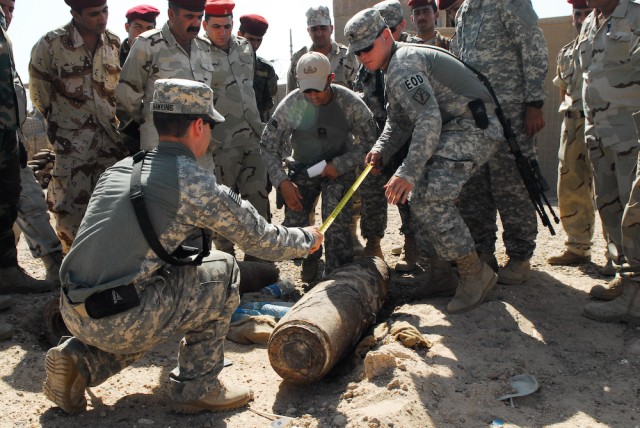
WASHINGTON (Army News Service, Feb. 16, 2011) -- With the sixth annual Chemical, Biological, Radiological, Nuclear, and High-Yield Explosives Defense Summit underway, one of the Army's leaders in the field said it's a daily challenge to rebuff the efforts of insurgents in Iraq and Afghanistan.
"As we improve, so do our adversaries," said Col. Thomas Cartledge, chief of staff of the 20th Support Command, at the summit Wednesday.
Cartledge explained that the military's chemical and Explosive Ordnance Disposal, known as EOD, troops work persistently to develop research and new technology in defense of the nation. In support of threats abroad, Cartledge said there has been a transformation in the force structure and the Army has doubled its number of EOD troops.
"The biggest challenge right now is maintaining the force structure," Cartledge said, explaining there is a big demand for Soldiers in the EOD and chemical fields.
Formed in 2004, the 20th Support Command located at Aberdeen Proving Ground, Md., is responsible for all of the United States-based CBRNE Soldiers -- about 4,500 troops. The command is equipped for rapid deployment for Weapons of Mass Destruction elimination and site exploitation worldwide, as well as countering and defeating improvised explosive devices.
Last fiscal year EOD teams also responded to nearly 250 U.S.-based incidents.
"It's important for everyone to understand the capabilities that reside within the 20th Support Command. We have very unique capabilities and very unique challenges," Cartledge said.
Some of the unique capabilities recently developed, Cartledge explained, include the Single Threat Integration Radiological System -- an inter-linked sensor system that uses both ground and aerial sensors to feed back to a single computer.
Another current development is the improvement of mobile chemical test sets for the battlefield -- similar to those seen in airports. Cartledge said it is important for test sets to be lightweight, portable and non-invasive to enable Soldiers to look for trace chemical residues.
The continual expansion of the Army's chemical and biological protective arsenal comes at great expense, but it's one that Cartledge thinks is well worth the Soldiers' lives that are saved.
"When you look at all our potential adversaries, most of them either have or want a Weapons of Mass Destruction program. Those are large-scale threats that can be done with very small devices," Cartledge said. "We know the terrorist community very much wants to acquire WMD to potentially use against us, so for the near term I think the 20th will stay in business."
The 20th Support Command also works closely with the civilian defense and intelligence communities, and the Soldiers are sometimes called upon as technical assets. They also regularly participate in joint training exercises in case of a national emergency.
Cartledge noted that if a chemical or biological threat is suspected, anybody -- military or civilian should call their local authorities or 911. When local authorities discover unexploded ordinance, they often call the nearest EOD unit. For more information, visit the command's website at www.cbrne.army.mil.
Related Links:
Army.mil: Science and Technology News
STAND-TO!: CBRNE Consequence Management Response Force
U.S. Army 20th Support Command
U.S. Army Explosive Ordnance Disposal (EOD) Specialist (89D) Career Opportunities

Social Sharing